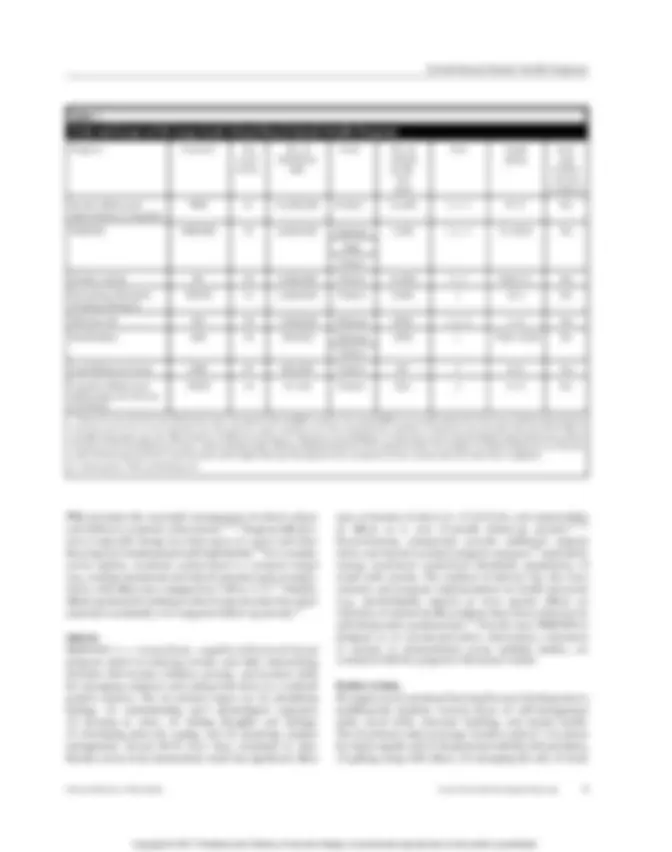








Study with the several resources on Docsity

Earn points by helping other students or get them with a premium plan


Prepare for your exams
Study with the several resources on Docsity

Earn points to download
Earn points by helping other students or get them with a premium plan
Community
Ask the community for help and clear up your study doubts
Discover the best universities in your country according to Docsity users
Free resources
Download our free guides on studying techniques, anxiety management strategies, and thesis advice from Docsity tutors
Abstract: Untreated mental health problems are among the most disabling, persistent, and costly health conditions.
Typology: Thesis
1 / 11

This page cannot be seen from the preview
Don't miss anything!







Abstract: Untreated mental health problems are among the most disabling, persistent, and costly health conditions. Because they often begin in childhood and continue into adulthood, there has been growing interest in preventive mental health programs for children. In recent years, several such programs have been implemented at regional, state, or national scale, and although many experimental studies have documented positive outcomes of individual programs, this article represents the first attempt to systematically compare the largest programs in terms of scope, scale, and dose. The school- based mental health programs discussed in this review appear to have reached more than 27 million children over the last decade, and many of these programs have collected systematic outcomes data. The role that such programs can play in low- and middle-income countries (LMICs) is a secondary focus of this article. Until recently, wide-scaled, preventive, mental health interventions for children have been studied almost exclusively in high-income countries even though around 80% of the global population of children reside in LMICs. Since a number of programs are now operating on a large scale in LMICs, it has become possible to consider child mental health programs from a more global perspective. With both the increasing diversity of countries represented and the growing scale of programs, data sets of increasing quality and size are opening up new opportunities to assess the degree to which preventive interventions for child mental health, deliv- ered at scale, can play a role in improving health and other life outcomes. Keywords: children’s mental health, large-scale programs, prevention, school-based interventions
he need to prioritize child and adolescent mental health is compelling since an estimated 13% of youth under 18 years old worldwide have significant mental health problems.^1 The most common disorders are anxiety, disruptive behavior disorders, attention-deficit/hyperactivity disorder, and depression. Numerous studies have shown that child mental health problems often persist into adulthood, especially if left untreated in childhood, 2 and that adult mental illness is among the most disabling and costly condi- tions in public health. 3 The high prevalence of mental health problems and their associated negative outcomes,
not only for long-term mental health but also with respect to educational and occupational attainment as well as impaired social consequences, suggest that finding ways to prevent mental health problems should be a major priority.^4 For these reasons, there has been much interest in searching for effective and scalable interventions that could improve mental health from childhood to adulthood. Since the vast majority of children and adolescents spend considerable time in schools, school-based programs have received increasing attention.5,6^ Although results from experimental studies have demonstrated significantly improved outcomes for children who participate in such programs, until now there has been little evidence that such programs could be implemented at scale in low- and middle-income countries (LMICs) or high-income countries (HICs), and even less evidence that, if im- plemented at scale, these programs would lead to population- wide improvements in mental health, health, education, or social outcomes. A recent editorial in the Journal of the American Academy of Child and Adolescent Psychiatry suggested that to address this gap, “large-scale programs need to be... evaluated as they are created and implemented in real-world settings, and further refined as evidence is generated.”7(p 793)^ The cur- rent review is consistent with that recommendation. Over the past few years, the scale and scope of children’s mental health programs have increased considerably, now reaching whole districts, counties, states, provinces, and even whole
From: Harvard Medical School (Drs. Murphy and Jellinek); Departments of Psychiatry (Dr. Murphy) and Pediatrics (Dr. Jellinek), Massachusetts General Hospital, Boston, MA; Clinical Child Psychology Program, University of Kansas (Ms. Abel); Department of Psychiatry, University of Maryland School of Medicine (Dr. Hoover); Department of Psychiatry, Oxford University, Warneford Hospital, Oxford, UK (Dr. Fazel). Original manuscript received 5 August 2016; revised manuscript received 22 November 2016, accepted for publication subject to revision 3 December 2016; revised manuscript received 14 December 2016. Correspondence: Michael Murphy, EdD, Department of Psychiatry, Massachusetts General Hospital, 55 Fruit St., Boston, MA 02114. Email: mmurphy6@mgh.harvard.edu Supplemental digital contents are available for this article. Direct URL citations appear in the printed text and are provided in the HTML and PDF versions of this article on the journal’s Web site (www.harvardreviewofpsychiatry.org). © 2017 President and Fellows of Harvard College DOI: 10.1097/HRP.
Harvard Review of Psychiatry www.harvardreviewofpsychiatry.org 1
countries with tens of millions of children involved. The establishment of large-scale programs in real-world settings has also created new opportunities for cross-program com- parisons, continuous quality improvement, and possibly, soon, the evaluation of population-scale improvements. To- ward these ends, the current review attempts to identify the largest preventive interventions for children’s mental health and to compare them in terms of their scope, scale, and dose. The degree to which such programs have been imple- mented in LMICs is a secondary focus of this article. Until re- cently, widely scaled preventive mental health interventions for children have been studied almost exclusively in HICs, even though about 80% of the global population of children reside in LMICs.^6 Since a number of programs are currently operating at a large scale in LMICs, it is now possible to con- sider child mental health programs from a global perspective. With both the growing scale of programs and the increasing diversity of countries represented, data sets of increasing quality and size are becoming available. The access to large data sets makes it possible to conduct the analyses needed to assess the impact of preventive interventions for child men- tal health on improving population health in a wide range of real-world settings.
To identify the largest programs, we conducted an initial search using PsycINFO and MEDLINE for articles published in English before December 2015 with combinations of the following key search terms: school or school-based, mental health, therapy, treatment, program, intervention, prevention, and national or state. This search identified 497 references. After the exclusion of duplicates and studies that did not examine children or mental health interventions, 45 studies remained. Several of the references identified were review articles, and we examined the programs mentioned in those reviews for other possible program candidates. We also reviewed the reference lists of three recent review articles on preventive interventions in HICs, 5 LMICs, 6 and social- emotional learning programs 8 to identify any additional large-scale mental health programs that might have been missed. In addition, we queried experts in the field. We fo- cused this review on mental health preventive interventions for children implemented in school settings. Although pro- grams focused on other types of interventions (such as those for substance abuse, anger management, or suicide preven- tion or those aimed at more global social-emotional learning) sometimes assess indicators like psychiatric impairment or societal outcomes (e.g., employment, disability, violence, or quality of life) that are of importance in public health, we ex- cluded such programs unless they specifically mentioned the term mental health in their overall program goals and unless they measured specific mental health or illness variables in their program evaluations. The final result was a list of eight programs (see Table 1) that met all of these criteria. We then contacted a developer or key researcher for each of the
programs and conducted a telephone interview with him or her in order to better understand specific program conceptu- alization and dissemination (see Supplemental Appendix I for the contact person and website for each program, available online at http://links.lww.com/HRP/A56). Following a widely accepted health service categorization, we used the three-tiered model of interventions to compare programs.9,10^ Tier 1 programs focus on mental health promo- tion or primary prevention and are applied to whole popula- tions (e.g., all of the students in a given school or classroom). Tier 2 interventions target specific vulnerable populations (e.g., children who have experienced potentially traumatic events or are already demonstrating some problems). Tier 3 interventions are aimed at supporting children with diag- nosed disorders. This review focuses primarily on prevention and therefore on Tiers 1 and 2 since Tier 3 is often synony- mous with actual treatment. Several of the programs we re- view include Tier 3 components, but those programs were not excluded, although programs that focused exclusively on Tier 3 were excluded. It is important to make early note of the limitations inher- ent in studying this area, for while numerous child mental health preventive interventions have been created and imple- mented, they are still difficult to categorize precisely. Locations for intervention, target populations, and child characteristics selected for intervention include many possible sources of het- erogeneity, as do the unique qualities of each specific school setting. For these reasons this review should be viewed more as a heuristic process or an attempt to gain perspective during a time of innovation than as a definitive list of programs. It may also be important to note that since our review was con- fined to studies published in English, it is possible that there are other large-scale programs that we are not aware of and are not included in this review.
The eight school-based preventive mental health interven- tions identified as having reached the largest populations of children are Positive Behavior Interventions and Supports (PBIS); 11 FRIENDS; 12 Positive Action (PA); 13 Promoting Alternative Thinking Strategies (PATHS); 14 Skills for Life (SFL); 15 MindMatters; 16 Good Behavior Game (GBG); 17 and Cognitive-Behavioral Interventions for Trauma in Schools (CBITS). 18 Seven of these interventions were devel- oped in HICs (either the United States or Australia), and the eighth (SFL) was developed in a LMIC (Chile). Each program is described below, with particular emphasis on results of ran- domized, controlled trials (RCTs) and program efficacy.
Positive Behavior Interventions and Supports PBIS, one of the most widely implemented programs reviewed here, emphasizes a positive social culture and establishes suf- ficient behavioral support for all students through a three- tiered prevention model. Several studies provide evidence that
J. M. Murphy et al.
2 www.harvardreviewofpsychiatry.org Volume 25 (^) • Number 5 (^) • September/October 2017
and mind, and (6) philosophy and thoughts-actions-feelings about self. One matched-pair RCT demonstrated a 37% decrease in violence-related behaviors, a 27% decrease in dis- ruptive behaviors, and a 41% decrease in bullying among stu- dents who participated in the program versus a control group.^27 Similar effects—specifically, dose‐response effects— have occurred long-term, particularly for disciplinary-behavior reductions and academic-achievement improvements.13,
Promoting Alternative Thinking Strategies The PATHS curriculum targets five major domains of functioning, including self-control, emotional understanding, positive self-esteem, relationships, and interpersonal problem- solving skills. An additional goal is the reduction of aggression and other problem behaviors. Lesson activities include role playing, storytelling, and attribution training. According to the CASEL social-emotional learning (SEL) program guide,^29 PATHS incorporates several factors essential for effective, school-based SEL implementation, including integration of ap- proach and theory, multi-grade-level design, focus on the role of emotions and emotional development, ongoing support and training, and multiple outcome measures for program as- sessment. RCT research on PATHS generally suggests that if implemented with fidelity, PATHS practices are associated with reduced disciplinary infractions and aggression in U.S. schools, but these findings were not replicated in a recent UK study.^30 Of note, several cluster RCTs have demonstrated that control students have increases in normative beliefs about aggression over time, whereas PATHS students improved in nonviolent in- terpersonal functioning (e.g., nonviolent problem solving and non-aggressive social skills). 30,31^ Effects on academic achievement has also been documented: writing proficiency and math proficiency were 1.5 and 1.63 times higher, respec- tively, for the intervention versus control groups.^32 Although these effects are relatively small for academic achievement, this result is not surprising since academic improvement is not the primary target of PATHS (conduct behaviors are). The fact that effects have carried over into academic achieve- ment suggests the broader influence of PATHS on multiple areas of child well-being.
Skills for Life The SFL intervention is based on the three-tiered model recommended by the World Health Organization.^9 In Tier 1, children, teachers, and parents receive primary prevention activities, which were designed to strengthen the school’s capacity (e.g., improving classroom climate, promoting teachers’ well-being, promoting parents’ participation) for supporting children in their development (e.g., social and emotional challenges). 33 In Tier 2, secondary preventive ac- tivities are targeted toward children who have been identi- fied at risk of emotional and behavioral problems through a screening process. 34,35^ In Tier 3, children with severe risk are referred to external mental health services for individ- ual evaluation and treatment.
SFL was developed by trained clinicians based on a national mental health standard, and is skill-based in its approach to workshops. Results from a large national quasi-experimental study^36 provided preliminary evidence that the positive impact of participation in the Tier 2 intervention on a number of behav- ioral and academic outcomes was significant. At-risk students who attended more sessions of the intervention showed greater improvements in parent- and teacher-rated behavioral-health measures and in annual school attendance than did at-risk stu- dents who attended fewer sessions. Effect sizes for these differ- ences ranged from .08 to .16 (Cohen’s d), and these differences, while small, were deemed to be important given the two-year follow-up interval from pre- to post-test. Results were also thought to have clinical significance, in that at-risk students who attended most of the workshops were 13%–28% less likely to remain at risk than were at-risk students who attended fewer workshops.^36
MindMatters MindMatters is a program for promoting mental health that embeds practices into the everyday school curriculum with a particular focus on promoting mental health awareness (coping skills, bullying, resiliency).16,37^ Specific techniques in- clude social- and emotional-learning programs, emotion- regulation strategies, and coping skills for stress and anxiety. While no RCTs have been completed to date, several published quasi-experimental studies have demonstrated its effectiveness in improving behavioral and academic outcomes.16,
Good Behavior Game GBG is a program for promoting behavioral health that is ad- ministered in the classroom for all students. GBG targets high-risk behaviors, such as disruptive classroom behaviors, aggression, and noncompliance, and is aimed predominantly at primary school children. It is a brief game played in the classroom setting with goals that include the promotion of self-regulation and teamwork.^17 Most notably, long-term outcomes from childhood through young adulthood demon- strate the significant influence of the game on minimizing sub- stance use in young adulthood.^17
Cognitive-Behavioral Intervention for Trauma in Schools CBITS is a cognitive-behavioral intervention provided by mental health clinicians, aimed at reducing trauma symptoms among at-risk primary school children. The program uses a cognitive and behavioral approach to improve students’ ad- justment to past traumatic events (violence, natural disasters) by teaching students relaxation techniques, social-problem solving, and cognitive restructuring. The program is aimed at the general school population but has flexible programming so that it can target relevant racial, ethnic, and socioeconomic groups. Results from several trials demonstrate posttraumatic stress symptom reduction immediately post-intervention and at 3- and 6-month follow-up.^39 –^41 Effectiveness has been dem- onstrated among youth exposed to violence^39 and natural
J. M. Murphy et al.
4 www.harvardreviewofpsychiatry.org Volume 25 (^) • Number 5 (^) • September/October 2017
disasters,^40 and youth with clinically significant posttraumatic stress.^41 Multiple respondents’ reports have helped to solid- ify consistency of symptom reduction from several perspec- tives and across contexts (e.g., behaviors at home vs. school). Intervention fidelity has been established,^39 and consistency of implementation assists maintenance of pro- gram efficacy over time, across studies, and in community (urban) settings. 40, The specific areas included under the scope, scale, and dose of each of the above programs are summarized in Text Box 1 and then described in more detail in Table 2 and in the text below.
The first aspect of scope considered is the degree to which interventions are prevention oriented versus treatment ori- ented. As shown in Table 2, all programs provide Tier 1 (universal) support to all students. PBIS, FRIENDS, and SFL also adapt their Tier 1 programs to meet the needs of at-risk students (Tier 2). CBITS involves only a Tier 2 inter- vention; it provides sessions for youth at risk for posttrau- matic stress and for internalizing/externalizing problems. Two programs, PBIS and MindMatters, provide their interven- tions by means of “continuous support,” with the programs’ materials integrated into the framework of the existing curric- ulum, rather than as a separate intervention activity. The scope of interventions can vary regarding the targeted domains of child functioning. Since the development of men- tal health interventions is both supported and represented by a well-studied body of literature, interventions aimed at
improving “mental health” are the focus of this review. Even within this focus, however, the programs included in the present review overlap with a number of closely related fields, variously labeled as social-emotional learning/SEL, well-being, resilience, or anti-bullying. As indicated in Table 2, five of the eight programs included con- tain elements of SEL, although the primary target of those programs is still mental health. CBITS is the only program that is formulated as a Tier 2–only framework, and it is also the only program that contains no SEL components. Interventions that are solely or primarily SEL, although widely disseminated, have been excluded from this review. For example, Lions Quest, one of the most widely dissemi- nated programs, describes itself as a purely SEL program, and it does not explicitly target mental health as an outcome. Although it has been implemented in 90 countries (many of them LMICs) and has demonstrated effectiveness in several RCTs, those studies have generally investigated the relation- ship between SEL and one or more of the following outcomes: positive behavior, drug and alcohol awareness, connection to school, and academic performance. These behaviors could po- tentially have a direct impact on mental health outcomes, but the existing studies do examine that particular connection.
In investigating the scale of preventive mental health interven- tion programs for children, we took into account four sepa- rate factors: the total number of children reached to date, the number of children reached per annum, whether the pro- gram has been implemented at scale (national, provincial, or state), and whether it has been implemented in a LMIC. As noted above, our estimates of scale were based primarily on telephone interviews with the developers or evaluators of each program. Because of the different ways that large-scale programs are rolled out, these numbers can only be rough es- timates; hence, rounded numbers are presented. As shown in Table 1, the programs covered by this review, along with the approximate number of students reached to date, are (1) Positive Behavioral Interventions and Supports (10,500,000), (2) FRIENDS (8,000,000), (3) Positive Action (5,000,000), (4) Promoting Alternative Thinking Strategies (2,000,000), (5) Skills for Life (1,000,000), (6) MindMatters (300,000), (7) Good Behavior Game (200,000), and (8) Cognitive-Behavioral Intervention for Trauma in Schools (97,250). The geographical scale of each program review, whether national, state/province, or school district, is presented in column 6 of Table 1. Three of the programs have reached national scale (FRIENDS and MindMatters in Australia, and SFL in Chile); FRIENDS has also been implemented on a state/province level in the United States. A number of pro- grams have been implemented by whole school districts, in- cluding PATHS, PA, CBITS, PBIS, MindMatters, and GBG. FRIENDS is perhaps one of the most globally dissemi- nated programs, implemented in more than a dozen countries.
Text Box 1 Areas Considered for the Review of School-Based Mental Health Interventions
Area considered Information included Scope Intervention type (Tier 1, 2, or 3) Age of children eligible for intervention Location of intervention Mental health problem targeted Scale Total number children reached to date Total number of children reached per annum Has program been implemented on a national or province/state scale? Has program been implemented in lower- and middle-income countries? Dose Number of hours that the student was seen Inclusion of teacher, parent, or whole-school components?
School-Based Mental Health Programs
Harvard Review of Psychiatry www.harvardreviewofpsychiatry.org 5
FRIENDS has been implemented on a national, state, and dis- trict scale in Australia since the early 1990s, with the first RCT completed in 2001.^12 It has recently become a national pro- gram in New Zealand, where the government makes it avail- able to all of its elementary schools (although the rate of actual participation is unknown). Additionally, for the past five years, FRIENDS has been an official program of the province of Alberta, Canada. The program has been adapted for use in the United Kingdom^42 and also in Brazil, Finland, Hong Kong, Ireland, Japan, Sweden, and Taiwan. SFL is another program running on a national scale. It is offered by the Chilean department of education and imple- mented in all 15 of the country’s regions and most of its large school districts. The program targets schools with high levels of poverty and other indicators of social risk. As of 2016, SFL was running in more than 2000 elementary schools, where it reaches about 320,000 first through fourth graders each year. Related programs for middle-school and preschool children probably bring the number of students reached each year in Chile to about half a million. Finally, MindMatters/KidsMatter is a program provided by the government of Australia. It has been operating since 1996 and has been a national program for the past decade, with revisions and expansions (including the merging of pre- school, primary, and young-adult versions with the secondary school version). MindMatters, an Australian initiative that promotes children’s mental health in the school setting, was originally designed for secondary school students and has re- cently been expanded to provide a version for primary schools (KidsMatter), preschools, and young adults. Some es- timates have suggested that MindMatters is used, in some form, in up to half of all secondary schools in Australia and a similar proportion of elementary schools, and that New Zealand is moving ahead with an implementation plan to en- sure its incorporation in all the country’s elementary schools. Although none of the other five programs covered by this review have been implemented at the state/provincial or national level, three have been implemented in whole school districts or in a large number of individual schools, and these programs include some of those that have actually reached the most students. PBIS, PA, and PATHS have been imple- mented to cover a total of about 17 million children thus far. These programs have been operating for an average of about 25 years, highlighting their feasibility. All three have strong affiliations with universities or research institutes and have been evaluated, as described earlier, in more than 30 RCTs. It is important to note that of the eight programs in the cur- rent review, three—FRIENDS, SFL, and GBG—have been implemented to scale in LMICs. FRIENDS has been imple- mented in more than 800 schools in Brazil and in several dozen schools in Mexico. SFL was created by Chilean health and mental health professionals in collaboration with educa- tional professionals in the late 1990s, when Chile was consid- Table 2Continued ered to be a LMIC. Chile’s recent economic progress led it to
Tier 1
Tier 2
Tier 3
CBITS
Specific symptomarea:posttraumaticstress
CBT
Mental healthprofessional
f^
__
__
10 group, 1
-^3
individual, 2parent, 1teacher
11
-^16
__
__
BA, bachelor
’s degree; CBITS, Cognitive-Behavioral Intervention for Trauma in Schools; CBT, cognitive-behavioral therapy; GBG, Good Behavior Game; MM, MindMatters; PA, Positive Action;
PATHS, Promoting Alternative Thinking Strategies; PBIS, Positive Behavioral Interventions & Supports; SEL, Social-emotional learning; SFL, Skills for Life.a^ Continuous support means that the program is integrated into the framework of the school curriculum and environment; teachers are trained to follow program concepts/guidelines for the entirelength of time that the children are in the school setting.b^ Classroom teachers implement Tier 1, and mental health specialists or school counselors implement Tier 2 or Tier 3.c^ Number of sessions varies, depending on grade level. School-age children typically receive 140 sessions. Target dose for all grade levels is 15 minutes/day, four days/week.d^ Sites can adapt Tier 1 (universal) program to match needs of at-risk children.e^ In Chile, many mental health services are provided by entry-level clinicians who have a college degree plus a certificate documenting an additional year of clinical training in psychology or socialwork. Most of the SFL services are provided by these entry-level clinicians.f^ CBITS online training manual is also available for school teachers.
School-Based Mental Health Programs
Harvard Review of Psychiatry www.harvardreviewofpsychiatry.org 7
be reclassified as a HIC in 2013, but for the purpose of this re- view, it has been classifield as a LMIC based on its history. SFL remains a “homegrown” program with no replications in other LMICs or HICs. The third program to reach large- scale implementation in LMICs is GBG. While most replica- tion studies of GBG have been completed in HICs such as Belgium, France, Netherlands, United Kingdom, and United States, the program has also been implemented on a smaller scale in Brazil.
The concept of dose, although very important, can be difficult to calculate across programs since the units of intervention vary so widely. While the dose of most programs can be described using the number of hours of intervention each stu- dent receives per day/week/year, two of the programs (PBIS and MindMatters) focus on providing the intervention through what they call “continuous support,” which means that the program is integrated into the framework of the existing school curriculum or environment rather than added on as a new protocol. Teachers are trained to follow program concepts/guidelines throughout the time that students are in the school setting, as noted in Table 2. SFL, which has been operating on a national scale for more than a decade,15,36,43^ is a good example of several of the key concepts of dose used in this review. SFL aims to be a compre- hensive preventive intervention for mental health by provid- ing all three tiers of intervention. As shown in Table 2, the SFL intervention for Tier 1 involves a dose of five hours of self-care for all teachers in participating schools, with some schools also providing a similar two-hour module for parents and an additional five hours for all students. For Tier 2, all students who screen positive are referred to a ten-session (1.5 hours each) cognitive-behavioral type group run by men- tal health professionals. Another component of the Tier 2 in- tervention is that parents of the students identified as being at risk receive three sessions, and the student’s teacher, two ses- sions. In total, the Tier 2 intervention provides about 19 hours of intervention per student. For Tier 3, all students who are referred by their teachers as having serious problems receive a one-hour evaluation by the mental health clinician who runs the school workshops. Students who are found to need additional intervention (e.g., treatment for depression or attention-deficit/hyperactivity disorder) are referred to clini- cians in the local community. The dose of CBITS can also be readily calculated. While it is the smallest of the programs reviewed here, its impact has been demonstrated in a number of experimental studies.^39 –^41 The program provides ten group sessions, one to three indi- vidual sessions for each student, two psychoeducational ses- sions for parents, and one teacher session. Student sessions occur weekly and last a full class period. PATHS is another program in which the dose can be calculated in a relatively straightforward manner. The core program consists of 36 – 52 class lessons depending on the child’s age. At each
level, PATHS is taught an average of two to three times per week in 20–30 minute sessions and includes lesson objectives and scripts to encourage systematic implementation (although teachers have flexibility and may adapt a lesson structure based on particular group needs or teacher style). Of note, since both PA and PATHS entail comparatively large dosages, achieving fidelity in program implementation may be more challenging, especially in other cultures, in which more exten- sive translation and adaptation would be required. By contrast, the FRIENDS program involves a smaller dos- age, with ten weekly sessions and two booster sessions (one and three months after program completion). Each session is 75–90 minutes in length. Sessions have a specific sequence, structure, and topic (cumulative effect). For both Tier 1 and Tier 2, the dose is about 17.5 to 21 hours per student. PA (both a Tier 1 and Tier 2 program) also uses a smaller, specific intervention approach, with children typically receiving 140 15-minute sessions (35 hours) per year. GBG operates on a similar model. Children receive 30-minute lessons daily throughout the 36-week school year (90 hours altogether). The game is played each day as part of normal instruction. Both PA and CBG provide lessons that are implemented through the general school curriculum and focus on self- regulation skills, social skills, and mental health promotion. Unlike the six programs reviewed above, the dose that each participating student receives in the remaining two pro- grams, MindMatters and PBIS, is more difficult to calculate. We have classified these programs as providing the interven- tion through a systemic framework. For example, core ele- ments of PBIS are integrated into the philosophy of the full school/organization and woven into traditional subject les- sons rather than pulled out as distinct mental health lessons (see Table 2 for more detailed description). The dose of the in- terventions received by individual students is impossible to calculate. PBIS is provided by school staff and teachers with specific training in the model. MindMatters provides another example of the way that a continuous support/framework approach makes it difficult to assess individual student dose. Like PBIS, MindMatters provides structure and guidance within the school, but is malleable and thus allows organiza- tions to build curricula that fit the needs of individual schools,^37 again making it difficult to compute the dose of the program received by individual students. MindMatters has components for different stakeholders in the school, in- cluding pupils, principals, teaching and nonteaching staff, parents, and the community around the school. Some of the manuals and exercises are directed to pupils; others are for school staff. Congruent with its universal approach, teachers gain skills to promote and support all students, regardless of mental health status.^44
This review has identified the school-based preventive inter- ventions for children’s mental health that appear to have reached the largest populations, whether defined using the
J. M. Murphy et al.
8 www.harvardreviewofpsychiatry.org Volume 25 (^) • Number 5 (^) • September/October 2017
that compare existing and new programs to the expressed needs of key stakeholders (such as school staff and commu- nity groups, as well as students and parents). With the grow- ing availability and diversity of programs, we can now pay greater attention to assessing the processes and practices of implementation that are associated with successful, widely disseminated, and sustainable programs, and also to program limitations or liabilities that may impede adoption. Concepts like fidelity, appropriateness to local settings, penetration, and adoption must be taken into account as we study what has and has not worked in the scaling up of large programs such as these. Finding ways to incorporate data from imple- mentation and outcome measures and aligning them more with the broader outcomes interests of schools and their as- sessment procedures will maximize our ability to learn from these programs and implement them further. Given the call to improve accessibility and relevance of ser- vices to school-age populations,^4 the evaluative frameworks of school-based mental health programs need to be improved over the coming years. The available research supports the long-held belief that such school-based programs continue to be one of the most promising types of preventive mental health interventions available for children. When combined with the exponentially growing data sets from large-scale, school-based mental health implementations, the emerging field of implementation science has the potential to provide the foundation needed to develop the evidence base and to improve population-wide health outcomes for the next generation.
Declaration of interest: Dr. Hoover serves as a National Certified Trainer for the Cognitive Behavioral Intervention for Trauma in Schools (CBITS) and, for some of these train- ings, is paid as an independent contractor.
Acknowledgments: The authors gratefully acknowledge the support of the Fuss Family Fund, and would like to thank Javier Guzmán for his comments on earlier drafts of this manuscript and Cara Lucke for her help preparing it for submission.
REFERENCES
interventions in schools in high-income countries. Lancet Psychi- atry 2014;1:377–87.
J. M. Murphy et al.
10 www.harvardreviewofpsychiatry.org Volume 25 (^) • Number 5 (^) • September/October 2017
School-Based Mental Health Programs
Harvard Review of Psychiatry www.harvardreviewofpsychiatry.org 11